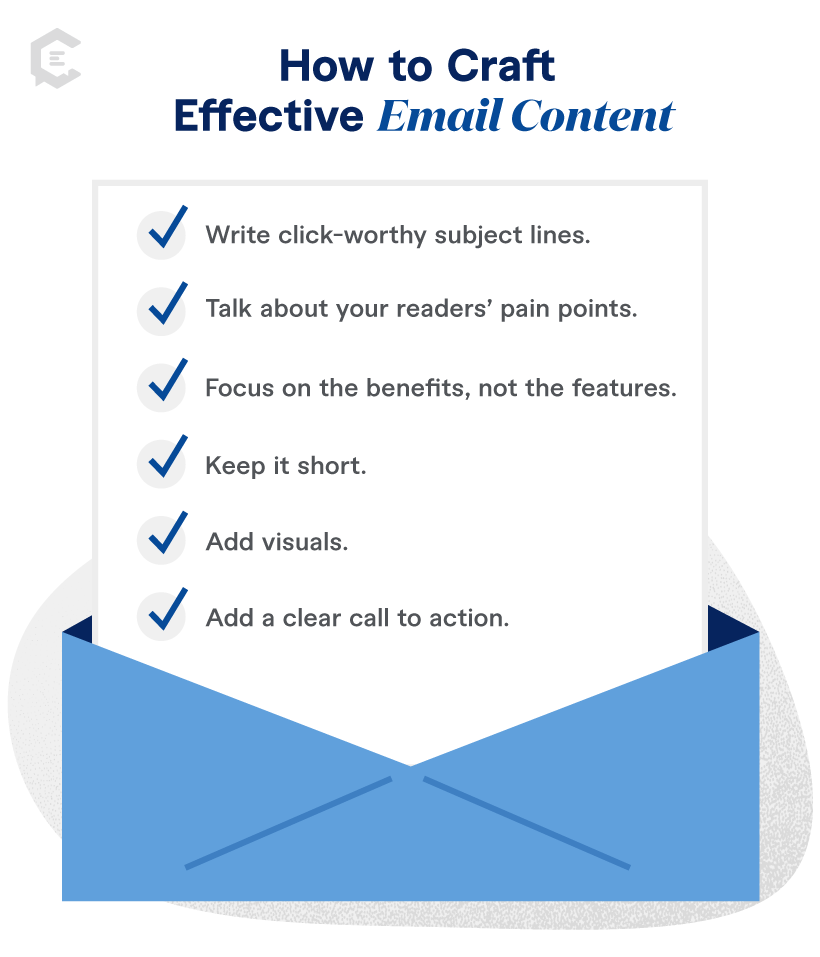You can’t overlook the value of email marketing when it comes to content distribution. After all, content marketing is highly regarded for its exceptional capability of generating an ROI of over 3,600 percent.

Marketers often report an impressive average of 14.1 percent for open rates, which is generally considered outstanding by industry standards. That is why most marketing leaders look to email marketing to bolster their content distribution efforts — it has proven effective.
If you’re considering doing the same, this guide is for you. We will explore the ins and outs of integrating email marketing into your content distribution strategy.

The Value of Email Marketing in Content Distribution
Email marketing brings two significant benefits to any content distribution strategy:
Directness and personalization
When your content is served directly via email, it doesn’t contend with other marketing elements present on mediums, such as social media sites, search engines, or even blog sites.
When your email messages are opened, your readers don’t see pop-ups or banner ads, among other marketing materials. The experience is much more direct, focused, and personalized.
Measurable outcomes
Most email marketing platforms have robust and advanced analytics functionalities that enable users to track the results of their campaigns.
The users can track their open rates, clicks, unsubscribes, etc.
Campaign optimization then becomes so much easier due to the measurable outcomes.

Crafting Effective Email Content
Your email marketing performance hinges on the quality of your email content.
With carefully crafted email content, you’ll get lots of opens and clicks. With poorly crafted content, however, your audience won’t even open your messages.
Consider the best practices below for creating email content.
- Write click-worthy subject lines. Use power words. These words paint a strong mental image for readers, compelling them to click open your email messages. Some examples of power words include ‘revolting,’ ‘powerful,’ and ‘danger.’
- Talk about your readers’ pain points. When you mention your readers’ pain points, they are reminded of the hassle and inconvenience they experienced. This causes them to be emotional, which then makes it easier for you to elicit a response from them.
- Focus on the benefits, not the features. Instead of saying your content is short and actionable, mention that your email list can save time and effortlessly follow the tips.
- Keep it short. Chances are, your readers are busy. Because of this, you need to keep your email messages short and crisp. That way, when they skim through your email, they won’t think twice about reading it because your email content is short.
- Add visuals. Another tip for creating high-performing email content is adding graphics or images. Graphics work as a breather of sorts. Instead of overwhelming your email list with massive blocks of text, you can sprinkle visuals in your email to break them into bite-size pieces.
- Add a clear call to action. Now that your readers are done reading your email content, give them a clear call to action so they know exactly what to do after reading. You can tell them to share your content, download, comment, etc.

Integrating Email Marketing with Other Content Distribution Channels
Use your email marketing seamlessly with other content distribution channels for more effective marketing campaigns.
Implement the following approaches.
Multi-channel strategies
Email marketing complements your social media pages, blog posts, and other channels by extending your reach, boosting engagement, and reinforcing your messaging via coordinated multi-channel strategies.
For example, you could announce a new product launch through your email newsletter, share the product’s features in-depth in your blog post, and promote it via social media platforms.
Your emails can lead your subscribers to your blog post for more details, while your social media posts can entice followers to sign up for your email newsletters for exclusive updates.
Cross-promotion tactics
Leveraging email can boost your content’s performance across platforms.
Consider the tactics below:
- Provide exclusive perks and content. As an incentive to engage with your content across other platforms, provide special offers or exclusive content to your email subscribers. For instance, email subscribers can get early access to exclusive Instagram content or live events.
- Promote content across platforms. Leverage your email newsletters to promote content such as podcasts and videos from other platforms. Include snippets or teasers to spark your audience’s interest and encourage click-throughs.
- Segment your email list. Sort your email list based on subscriber demographics, behaviors, and interests. It helps you tailor your content promotions to specific audience groups, boosting your content’s relevance and engagement. Marketing platforms like Mailchimp help you build segments easily (or use pre-built segments) and automate emails.
Measuring the Success of Your Email Marketing Campaigns
Measuring email marketing campaign success can help determine whether your efforts contribute to your overall goals and content distribution strategy.
Measuring email marketing success includes the following.

Key metrics and KPIs
Determining your email marketing campaign’s success starts with tracking crucial metrics and Key Performance Indicators (KPIs), such as:
- Open rate. The metric is the percentage of recipients who opened your email. High open rates indicate engaging content, compelling subject lines, and a strong sender reputation.
- Click-Through Rate (CTR). The CTR measures the percentage of recipients who clicked your email links. The metric indicates the effectiveness of your email content and CTA in driving engagement and expanding your reach by leading contacts to your specific landing pages or other content distribution channels.
- Conversion rate. The conversion rate measures the percentage of recipients who acted on your conversion goals, such as buying your product or downloading a resource. Tracking conversions tells you whether your marketing emails drive your desired outcomes, such as converting subscribers into paying customers.
Analytics tools
The best way to measure your email marketing campaign’s success is to use tools for tracking and analyzing email campaign performance.
Some of the top email analytics tools include the following:
- HubSpot. HubSpot’s email marketing tool includes robust analytics features to measure your campaign’s performance and optimize your strategies. The tool gives insights into clicks, email opens, conversions, and engagement metrics.
- Google Analytics. While Google Analytics isn’t specifically for email marketing, the platform can track user behavior and website traffic from your email campaigns. Setting up campaign tracking parameters on the tool lets you track email-driven visits to your website, goal completions, and conversions.
Trends and Innovations in Email Marketing for Content Distribution
Keep up with the latest content distribution trends for email marketing to adapt your approach and keep your efforts relevant and effective.
Emerging technologies

The emerging technologies and tools in email marketing include the following:
- Artificial Intelligence (AI). AI can analyze massive amounts of subscriber behavior and data to help you tailor your email content to individual preferences. AI can facilitate seamless audience targeting and segmentation for more effective content distribution.
- Automation. Automation tools streamline scheduling and sending emails to recipients, ensuring relevant and timely communication based on user actions.
- Personalized content recommendations. Survey data shows that 56 percent of consumers will buy again after a personalized experience. The figure highlights the effectiveness of personalization in driving conversions and sales. Personalized content recommendation systems use AI algorithms to analyze subscriber preferences and data and recommend relevant content based on that information.
Regulatory considerations
Besides trends and innovations, you must adhere to and stay updated on applicable regulations and laws in email marketing and content distribution, including the following.
- General Data Protection Regulation (GDPR). The GDPR provides guidelines on collecting, processing, and protecting personal data within the European Union (EU). GDPR compliance includes getting explicit consent for processing data, transparent data handling practices, and offering opt-out options for email subscribers.
- Controlling the Assault of Non-Solicited Pornography And Marketing (CAN-SPAM) Act. Adhering to the CAN-SPAM U.S. law helps you maintain sender deliverability and reputation to ensure your emails reach subscribers. Use honest email subject lines, give accurate sender details, provide subscribers with the opt-out option, and honor opt-out requests promptly to remain compliant.
You may also need to comply with other regulations depending on your and your email contacts’ geographic location and industry, such as Canada’s Anti-Spam Legislation (CASL).
Complying with email marketing and content distribution laws shows that your business adopts ethical practices.
It also helps you mitigate legal risks and build trust with your subscribers, leading to higher engagement and conversions.

Leverage Email Marketing to Bolster Your Content Distribution
Given the direct connection email marketing establishes with your audience, it’s a toolkit you must include in your content distribution arsenal.
Email marketing can bring you more eyeballs, audience engagement, and sales. The best part is email marketing is known to yield astronomical ROI.
With the help of seasoned content strategists and marketers, leverage content marketing now to bolster your content distribution initiatives.



